|
Introduction
The purpose of this page on the East Area Rapist case is not to establish that two perpetrators were involved. The purpose is to discuss the clues and evidence which suggest more than one crime attributed to the EAR could, in fact, have been done by another perpetrator. In essence, what is weighed here will most likely be weighed at the trial of J.J. DeAngelo. The outcome should prove enlightening to all those who have followed the case and have many unanswered questions. The upcoming trial must be as much about explaining as it is about conviction. There is still much doubt that a single perpetrator was responsible for all that DeAngelo now stands accused. For the defense to be able to introduce a reasonable doubt will shake the case against DeAngelo on several counts.
General Overview
As it stands, DeAngelo is popularly suspected of having been the Cordova Cat, a cat burglar who struck the East Area of Sacramento (fall to spring 1972-1973). This strange burglar hit Rancho Cordova and Carmichael and Citrus Heights. In Spring 1973 DeAngelo moved south to Exeter, California, a hamlet near Visalia. Here he is not only suspected of having been the weird Visalia Ransacker (spring 1974-winter 1975), he now stands accused of a murder (Claude Snelling) hitherto attributed to the Ransacker. Then moving back up to the Sacramento area to the foothills town of Auburn in 1976, he is suspected of having driven long distances to the East Area of Sacramento (where he had grown up) to become a terrifying home invading night rapist known only as the East Area Rapist (1976-1979). Then, having been fired from Auburn Police in July 1979, he moved down south and stands accused of being the home invading rapist/murderer known only as the Original Night Stalker (1979-1986).
The prosecution has essentially entangled itself with a huge problem. In the cascade of emotion following his arrest the prosecution wanted DeAngelo tried for more than the murders. They now included many of the East Area Rapist’s terrifying rapes as well. Yet the northern California rapes were long outside of Statute of Limitations. But a loophole was sought (and naturally found) that will be used (though it may not work) to charge DeAngelo for kidnapping in cases where EAR had taken the victim from the bedroom to the living/family room or backyard patio to rape them. EAR did this in most cases. Thus though the rape itself will not be prosecuted, these cases will be tried for the kidnapping charge.
Ironically, in its zeal the prosecution helped introduce what could be pathways for the defense to introduce exculpating evidence against DeAngelo. By introducing the rape/kidnapping cases this will now add dates, copious amounts of dates. Now in addition to the limited dates the prosecution was required to establish DeAngelo’s whereabouts for the murders, the defense has dozens if not over a hundred more dates whereby to introduce evidence that confirms DeAngelo’s whereabouts can be determined at given rape dates or significant EAR pre-attack prowling dates. Many of the EAR rapes were preceded by flaps of break-ins and prowling reports. The prowler sometimes broke into the victim’s house during this flap of break-ins. He rearranged things, stole victim photos, even unplugged or turned off the furnace— the same thing EAR would do during the rape attack. The defense has a good chance of proving DeAngelo’s whereabouts during some of these dates. Even if DeAngelo cannot be accounted for during the night of the rape, he might be exculpated for having been the neighborhood prowler. This would cast a reasonable doubt he was the EAR rapist. By successfully introducing enough evidence to indicate that DeAngelo imitated other perpetrators, or that there was another perpetrator afoot, it makes it impossible for a dutiful jury to convict him for any rape or murder where there is no DNA.
The upcoming battle in court is one that must be waged mostly by the prosecution. Not the defense. Defense always has an easier path. It may not make sense at first glance, but a defense attorney must just introduce a reasonable doubt.
And there’s more than enough reason to expect the defense to suggest a copycat effect. . .
A pattern exists suggesting the accused engaged in some copycat tactics. This pattern is most visible in the final crimes, those to which he is tied by crime scene DNA. The So. Cal murders show the pattern of imitating the M.O. of the Bedroom Basher (1978-1979). It needs only some minor backworking to suggest DeAngelo followed a pattern of copycat in the East Area Rapist crimes. For example, the first home invasion rape initially attributed to EAR occurred in Rancho Cordova on October 21, 1975, when DeAngelo was stationed far away in the central valley hamlet of Exeter. The first official EAR rape was on June 18, 1976, also in Rancho, when DeAngelo was still officially attached to the Exeter PD, 4 hours away, though there have been attempts to place him in Sacramento already. In addition, the very first description of EAR is that of a man who has lots of dark hair on arms and legs. This most certainly is not DeAngelo.
The accused J.J. DeAngelo can be tied to the So. Cal Original Night Stalker murders by actual crime scene DNA. But those murders in the north— Brian and Katie Maggiore; and Claude Snelling— are outliers with no DNA, and the result of different circumstances and M.O. In addition, there is no DNA for any of the Sacramento, Modesto, Stockton, and Davis, and most of the Contra Costa County, rapes; and descriptions of the East Area Rapist while in perpetration vary greatly. By successfully introducing that more than one crime spree was confused and overlapped onto each other gives us another EAR, an un-apprehended villain upon whom the defense can hang the suspicion for many of the crimes where there is no DNA.
The October 1975 rape mentioned above would seem deadly to the prosecution. It was preceded by a “ministorm” of EAR-like hang up phone calls, prowling, and even the putting out of an inconvenient porch light. This case puts an EAR-like pattern in place when DeAngelo ostensibly could not have been available for the entire week. It is a win/win situation for the defense to show this was indeed EAR or to show that this was not. One prospect introduces a terrible doubt  as to who was the original East Area Rapist; the other prospect introduces another perp was already in place and using the same M.O. as to who was the original East Area Rapist; the other prospect introduces another perp was already in place and using the same M.O.
This does not bode well for the Maggiore Double Murders (also in Rancho C), for which there is no DNA, and for which there is also more than one perp description. Like the October 1975 rape, these murders were preceded by a rash of EAR-like prowlings and hang up phone calls that had begun months before and came to a crescendo on the night of the murders. Very tellingly, thereafter the area of Cordova Meadows experienced no more of these prowlings, break-ins, and hang up phone calls. The connection of the murders to the prowling reports, breaking and enterings is so obvious, and put together by concise detective work, that to prove DeAngelo could not have been doing the prowlings and break-ins on the given dates is to heavily cast doubt he did the spontaneous murders.
No one kept the case of the EAR alive as much as Lt. (ret) Larry Crompton of the Contra Costa County Sheriffs. He is the Dr. Loomis of this case. Nevertheless, there is a sobering quote from him. In his book Sudden Terror, he speaks of one avenue of approach he followed during his investigation. He looked at the records of recent parolees to uncover one whose date of release could coincide with the beginning of the crime spree. “To our amazement, several parolees had committed rapes using similar M.O.s as those used by EAR.”
Thus without DNA the EAR M.O. in and of itself is not proof there was a single East Area Rapist. And when it comes to specifics of EAR’s actions within the house (how he spoke, etc), logically a cop like J.J. DeAngelo was the only one in a position to copycat. Although he was stationed in the foothills town of Auburn, years before he had grown up in Rancho Cordova and as an adult lived in Citrus Heights and worked for Roseville PD. His wife’s family continued to live in Citrus Heights. He had ample contacts with local law enforcement to know the details of the East Area Rapist’s M.O.
By DNA, DeAngelo can indeed be connected to 3 northern California rapes attributed to EAR. But these were in Contra Costa County, 1978-1979, occurring late in EAR’s crime spree in the northern area of the State. But EAR had began in 1976 (officially) in Rancho Cordova, an eastern suburb of Sacramento, then he concentrated in Carmichael and Citrus Heights. This is far from CCC and years apart. Again, there is no DNA here in Sacramento. And the early evidence and descriptions of the perpetrator are not indicative of DeAngelo.
Pattern is powerful, but eyewitness descriptions of the perp in perpetration are evidence. The eyewitness descriptions introduce something very disturbing for convicting DeAngelo for everything for which he now stands accused. We will come to these descriptions shortly.
Specifics
The clues in a few incidents may cascade out to favor both prosecution and defense, depending where the clues lead. One of these is the Haskell Avenue Incident. Although officially not a part of the EAR canon, it is significant. Instead of being preceded by a flap of break-ins and prowling reports, as reported in the October 21, 1975, rape, it was followed by a chain of events occurring over a week that indicate the Haskell Avenue family had been closely watched during that week by a vindictive predator. Was DeAngelo in a position to do this?
Typical of EAR, this Haskell perp had used an empty home as a base and was noted for his unusual agility. But most significant of all, this incident connects the perpetrator to a specific model of car. He nearly ran down deputy Marlin Weinberger with it. Using DeAngelo as the key, tracing it may prove vital to confirming the perpetrator’s identity. If it can be traced to DeAngelo, it may prove how he was able to get so many different cars, if he was the one and only EAR.
The car reports associated with some “prowler” in the neighborhoods before-the-fact of EAR attacks are the big mind bender. These came to be associated with EAR. Were all these cars simply a coincidence or can investigating DeAngelo’s background uncover his source for so many automobiles? What if investigating his background shows he had no such ability to get all the cars associated with EAR?
In terms of crime sprees, the case of the Visalia Ransacker is very significant. It is in play and, as viewed here, almost demands that DeAngelo be portrayed as a crafty copycat if he is to be convicted for the murder of Claude Snelling in September 1975. This was a major milestone in the crime wave of the Ransacker (1974-1975). Claude Snelling was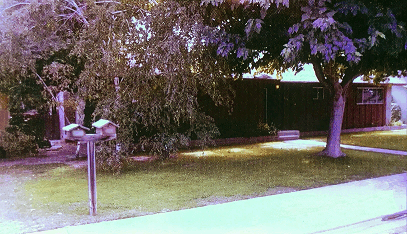 killed by a weapon stolen by the Ransacker at the previous VR robbery. Visalia PD was certain this made the Ransacker his killer. But it is not that easy. killed by a weapon stolen by the Ransacker at the previous VR robbery. Visalia PD was certain this made the Ransacker his killer. But it is not that easy.
The case of the Ransacker is significant for a number of reasons, foremost of these is the fact there was a contemporary attempt to connect the two crimes sprees, a connection which was vociferously rejected on solid grounds.
During the height of the EAR’s terror in the East Area of Sacramento (May 1977), Visalia Police detectives proposed to Sac Sheriffs that EAR was the perpetrator responsible for the previous rash of ransackings they had in Visalia over 1974-1975, and that he was even the murderer of Claude Snelling. They were in for an uphill battle. Visalia is a farm town 4 hours south of Sacramento in the San Joaquin Valley. And the description of the perp was radically different from those of EAR. Sacramento Co. Sheriffs refused to accept a connection. Rebuffed, Visalia PD waited a year and then in July 1978 felt out Sacramento PD. Sac PD only had a few EAR cases in their jurisdiction compared to a couple dozen in the Sac Sheriff files, but they showed more of an open mind. This led to a detailed Sacramento Union article declaring a solid link between the perps. This in turn led to a rather nasty exchange in the newspapers between the Sheriff’s spokesman, Bill Miller, and Visalia PD, wherein Miller angrily denounced any connection and those making it.
With the arrest and charging of DeAngelo in 2018, it was noted that at the time of the Visalia ransackings he had been a cop in the nearby hamlet of Exeter. He became a cop there in May 1973 and in that August the Exeter Sun had published a story introducing DeAngelo to the community. The picture was quickly found and placed next to a sketch of the Ransacker. It now seemed certain that DeAngelo had been the Visalia Ransacker and, moving back north to the 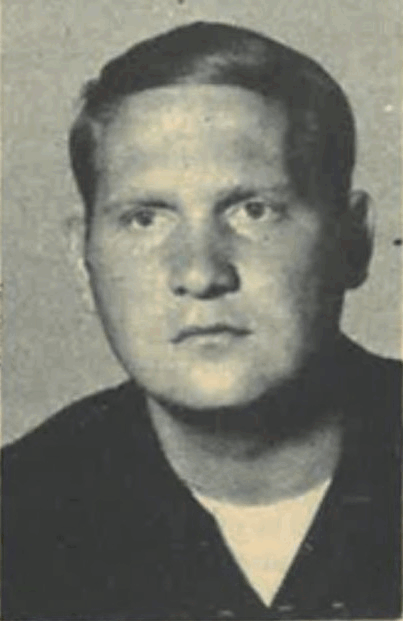 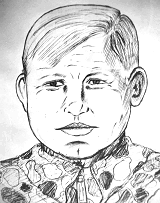 Sacramento area from which he had originally come, he then became EAR. The Ransacker had struck over 1974-1975. DeAngelo then moved back north in 1976 and EAR began to strike in June 1976. Sacramento area from which he had originally come, he then became EAR. The Ransacker had struck over 1974-1975. DeAngelo then moved back north in 1976 and EAR began to strike in June 1976.
The cascade began. DeAngelo was guilty of everything! He is now finally accused of Claude Snelling’s murder. In essence, the charge is now saying that the East Area Rapist and the Visalia Ransacker were and always were one and the same.
However, the timelines and descriptions are actually not so neat, and nothing has changed the evidence which had made Sacramento SD so adamant to begin with. It was based on Visalia PD’s own investigation. Since the purpose of this page is to outline the problems the defense can raise to exculpate J.J. DeAngelo in some of the rapes and murders (including that of Claude Snelling), it is best to interject here a truncated presentation of the Snelling murder and the strange case of the Visalia Ransacker.
The Visalia Ransacker
In the early 1970s Visalia was vexed by prowlers and petty thieves. But in April 1974 a strange pattern began to emerge. A prowler went to great lengths to discover when the residents of houses were not home. He appeared to prowl during weekdays and then entered homes on the weekends when the family was away. He entered but stole little of value— often blue chip stamps, the contents of piggy banks, coin collections, and then, more disturbingly, revolvers and ammunition. Despite the little of value stolen, he made an unnecessary shambles of the house, very often the bedrooms, and then especially the bedrooms belonging to the female members of the 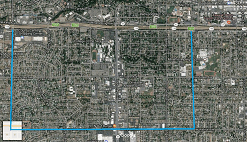 household. Their clothes would be scattered all over the floor. This earned this petty burglar the police nickname “ransacker.” household. Their clothes would be scattered all over the floor. This earned this petty burglar the police nickname “ransacker.”
The Ransacker concentrated in a confined area— south-central Visalia in the environs of College of the Sequoias. This was such a confined area that there never was a news article about him. No warning went up for homeowners to beware. As a result, homes were left unlocked, residents blithely went about their business. The rest of the State may have been locking itself up because of rampant crime, but Visalia was a small farm down in the heart of California’s bread basket. Life went on as it had 20 years before in the “idyllic” 1950s.
With no impediments, the Ransacker continued as an essentially ghostly prowler and strange house wrecker. On the night of November 30, 1974, for instance, he invaded 11 homes and made a shambles of them. Sometimes he didn’t steal anything. He just wrecked the interior. He was becoming stranger and stranger. For another example, at 522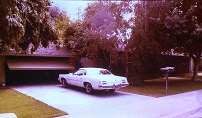 South Whitney, on Wednesday February 5, 1975, the family returned to find they had been prowled. They found a bottle of Jergens lotion that didn’t belong to them. The back slider was smeared with hand prints made in the lotion. Three days later (on the weekend) there was a prowler/peeper in their bushes. This guy was obviously a little “off.” South Whitney, on Wednesday February 5, 1975, the family returned to find they had been prowled. They found a bottle of Jergens lotion that didn’t belong to them. The back slider was smeared with hand prints made in the lotion. Three days later (on the weekend) there was a prowler/peeper in their bushes. This guy was obviously a little “off.”
Tennis shoe prints stamped about yards, small at only size 9, indicated how much this prowler/ransacker he stalked about south-central Visalia, even on nights where he didn’t strike. Visalia PD felt he was essentially a peeper. He watched young women in their homes. He was becoming more strange and fixated on the young females, so it would seem.
Toward the fall of 1975, there had been a year and a half of ransackings, probably close to 90 of them, plus unaccounted prowling reports. Still the Ransacker wasn’t news. Then on September 11, 1975, again on South Whitney, he came back to the neighbors of 522. This was 532 South Whitney. This was the Snelling home. The father was Claude Snelling, journalism professor at the nearby College of the Sequoias.
The perp pried the screen off a back window and took it across the street and set it on top of a neighbor’s camper trailer. He crossed the street again and gained entrance. He was doing something he had never done before. He entered the home at night while the entire family was sleeping. He found the mother’s purse on the counter and rifled through it, taking it outside and leaving it on the brick planter. He entered the daughter’s bedroom. Beth Snelling was sleeping when she felt someone laying on her and clutching her mouth and nose. She couldn’t breathe and awoke. Angry eyes were staring into hers, staring through holes in a dark ski mask. The assailant threatened her immediately.
“Don’t scream or I’ll stab you.” Then drawing a gun with his left hand from his back pocket, he yanked her up with his right hand and started to lead her to the backyard. “You’re coming with me.” 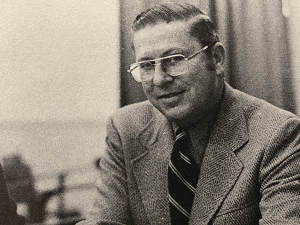
Beth Snelling began to resist, making enough noise to awake her father. The perp continued to lead her outside. Now Claude appeared at the top of the steps of the back door.
“What are you doing?! Where are you going with my daughter!?”
The masked man whirled around and shot Claude in the shoulder, spinning Claude around. But wounding wasn’t enough for the assailant. He shot him again. He then pointed the gun at Beth, but decided to kick her a few times in her face. Then he fled down the driveway. Claude ran to the front door to rush out and intercept him, not realizing how wounded he was. There at the door he dropped dead.
The police suspected the Ransacker. It was only now in the wake of Claude Snelling’s murder that greater Visalia began to hear about such a strange prowler afoot called the “ransacker.”
Although Beth Snelling really couldn’t identify her father’s killer better than saying light skin, round face and square jaw, Visalia PD was eventually able to link the killer to the Ransacker. The revolver used to kill Claude Snelling had been stolen 11 days prior at a strike attributed to the Ransacker on West Royal Oaks.
Visalia PD associated the Ransacker with that distinctive size 9 tennis shoe print. By December 1975 a pattern was laid down around 6 homes on West Kaweah and South Dollner. A PD stakeout was planned. Special Agent William McGowen was stationed in the garage of 1505 West Kaweah, waiting. The garage door was left open. It was the perfect position. From the pattern of footprints, the house next door, 1501, was expected to be the target house. Late at night, McGowen crouched and waited. A large, stocky figure slinked up along the shrubbery and peaked into the open garage door. He didn’t see McGowen. He didn’t enter. He padded along the side of the garage and started to fiddle with the back gate of the house next door— the target house.
McGowen quietly stepped out the garage and shined his flashlight on the prowler. “Police officer! Hold it right there!”
Startled, the prowler whirled around and ripped some kind of bunched up knit cap off his head (it looked like a ski mask rolled up). “Oh my God! Oh no! Oh my God, no!” The prowler was squirreling out in a high-pitched, effeminate voice. Add to this behavior a strange body description: tight jeans clutched his large hips and big butt, his shoulders sloped, together giving him a pear shape. A camo fatigue jacket was buttoned all the way up. He had short, stubby feet.
He wouldn’t obey McGowen but jumped the fence. McGowen emerged at the top of the fence and pointed his flashlight at him. The guy warbled “Oh my God! Please don’t hurt me! Oh my God, no!” in that high pitched effeminate voice. The antics went on and McGowen chased him through the yard. He jumped another fence, and McGowen again emerged at the top, shining his flashlight on him. But without warning the weird guy drew a gun with his left hand and fired. McGowen’s flashlight sailed from his grasp and he fell back, injured to his eye from shrapnel. He was stunned. The perp got away, with 11 pounds of stolen goods on him from houses he had already hit.
McGowen made sure to embed in his mind what the perp looked like. He was heavy set, under 6 foot, short legs with thick calves, ran in a zigzag fashion with knees close together, had a large rump. For some reason when first confronted by McGowen, the perp had ripped his cap off, which suggested to McGowen it was a ski mask that he didn’t want to be caught wearing. In any case, this revealed his hair as light blonde, parted on left. It was a military cut, much higher than the ears and no sideburns at all. Definitely not the fashion for 1975. He had a round face, square jaw— a baby face.
A few of these points matched the assailant at the Snelling murder. Beth Snelling had said that despite the ski mask, the assailant had light skin and hair (determined from the color of the eyebrows), had a round face with wide jaw. He also shot with his left hand.
After the McGowen shooting, the Ransacker was big news. He was No. 1 town villain. There were a couple of incidents of peeping in January 1976 where the peeper was described wearing the similar camo jacket. But on the whole the Ransacker was no more. The murder of Claude Snelling hadn’t stopped him, but it seems the encounter with McGowen was enough to throw a scare in him. Or, after January he simply moved on.
This is the case summary. Key points are presented in pictures below.
The Snelling Murder, Thursday September 11, 1975.
  
  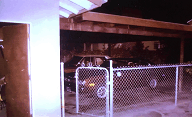
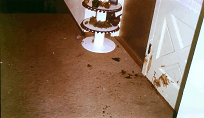 
The McGowen Incident, Wednesday December 10, 1975.
  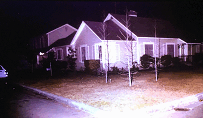
 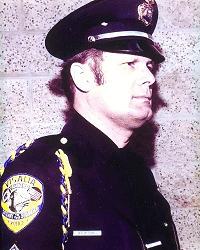 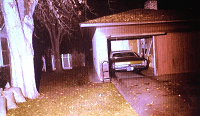
  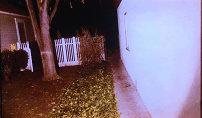
Ransacker or Ransackers?
The most fascinating and at the same time frustrating point about the Ransacker is that his image was assembled entirely after-the-fact. This image bears some developing here, how it came about and how it was anchored to what McGowen reported.
The Visalia Times Delta (March 4, 1976): “Immediately after the McGowen incident, the Snelling investigative force was beefed up and officers began combing the central Visalia residential area, questioning homeowners. . . Several persons were found who recalled seeing a prowler in their yard after dark. The prowler matched the same general description offered by McGowen.”
But it would soon become obvious this image was based on more than one prowler, one of whom was soon apprehended.
In March 1976, an 18 year old sandy blonde man was finally arrested for prowling and burglaries on Dollner Street, close to where McGowen had been shot at the December before. Before his arrest, the prowling activity on Dollner had caused a surge of interest in Visalia because police were certain that the Ransacker was afoot again. The Dollner prowler was described the same way, even down to shoe size, as the Ransacker. Yet here with a mad homeowner in pursuit he had dropped something and his fingerprints were lifted by police. The prowler had been identified as Rodney D. Boren. He was well known to the police, so he hadn’t started his petty burglaries and prowlings in March 1976.
Announcing the arrest of Boren, the lead detective John Vaughn said (Times Delta March 12): “the suspect has the same shoe size and physical appearance as the man believed to have killed Claude Snelling on September 11, 1975, and to have committed some 90 burglaries in south-central Visalia during the past two years.” Strangely, however, Vaughn insisted Boren wasn’t the Ransacker. For Visalia PD that meant he wasn’t the Snelling killer or the creep who shot at McGowen.
It must have been McGowen’s insistence that the man who shot at him was really quite strange, and Boren didn’t have all of the specific features McGowen had noted. Perhaps so, but how many of the neighbors questioned after-the-fact were actually describing Boren prowling in their yards? We don’t really know, but McGowen’s belief that there was another similar looking perp to Boren, but supposedly far stranger, would be bolstered later that year.
On September 23, 1976, a young man came into McGowen’s office and described his encounter with a strange prowler while visiting his girlfriend at her home on West Feemster. This was about 2 years before (Sept./Oct. 1974) during the height of the Ransacker crimes, and Feemster was at the heart of his crime spree at that time. A peeper was in the bushes. The boyfriend followed him and confronted him under the lamppost on South Sowell Street. He describes him as a WMA, 5'10", mid twenties, 185 pounds. His frame was definitely heavy. His hair was sandy blonde, stringy. His skin was pale, face unusually round, hairless— a baby face. His eyes were “slitty.” Pug nose. Ears were small and fat. Hips, rump, thighs, legs, were large, thick. Shoulders were round and sloping. He was described as walking and running with an awkward gait. He wore a brown jacket with tight cuffs. He sometimes was speaking to a third person who simply was not around.
Although given after-the-fact by 2 years, this is the first detailed description of a prowler in the area of south-central Visalia that matches the man who would shoot at William McGowen on December 10, 1975. This also becomes the last description of VR as it is essentially the same description given by McGowen of the man who shot at him. McGowen added that the VR had a notable cleft in his chin. This young man’s concise description must have clinched it for McGowen. This was the same guy. This was indeed the half-cracked Ransacker. 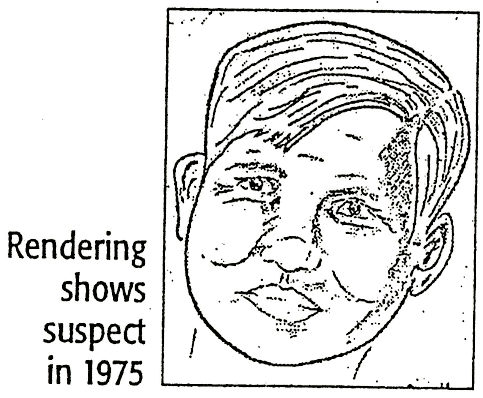 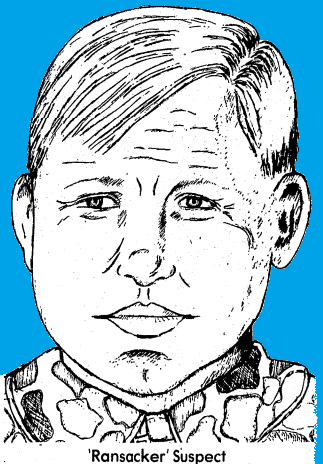
The sketches highlight the continuity of the image of the Ransacker. McGowen said he had a “military haircut” because it was unusually short for the times. The witness on Sowell Street said he had an Okie accent.
Interestingly, the only contemporary description comes from McGowen. Everything else is after-the-fact. Yet there was little reason for Visalia PD not to accept this as an authoritative description of the Ransacker.
East Area Rapist and Ransacker SNAFU
Having heard of the East Area Rapist case, in early 1977 Vaughn and McGowen appeared before Richard Shelby, one of the lead detectives on the case for Sac. Sheriffs. Shelby would later write of his experience with the 2 detectives in his own book on EAR, Hunting a Psychopath. Vaughn and McGowen had this profile wherein the criminal profiler had written that the Ransacker most likely worked for a utility company and had lived about 10 miles outside of Visalia. He rode his bicycle to and from work each day (True, the VR was never associated with a car). This led them to a suspect. Two days after the McGowen shooting this utility worker requested a transfer up north. He was now in Davis, California.
Shelby assisted them. They went to Davis, connected with the local cops. Davis PD stopped the suspect and chatted with him while Shelby, Vaughn, and McGowen, waited in a car and McGowen, the only true witness, watched. Shelby writes: “Special Agent McGowen began to squirm and in general became upset. This witness detective, who was seated behind me, was not able to identify this man with the huge calf muscles as the person who shot at him. Looking me in the eye, Agent McGowen said he had seen too many faces and heard too many voices to be able to identify the suspect.” As far as Shelby was concerned, the VR was before them. This suspect had been around Visalia, fit the unusual description, and had gotten out of there soon after the shooting. But it was obvious this “pear shaped” man wasn’t the lean, athletic East Area Rapist.
McGowen’s growing lack of confidence may have proven instrumental in events that would unfold a year later.
Spurned by Sac Sheriffs, it was July 1978 that Visalia PD made news by stating there was a Visalia connection to the East Area Rapist. It began with a lengthy article in the Sacramento Union. Zeus either came to visit the Sacramento Sheriff Headquarters or Sheriff Duane Lowe was capable of pitching lightning bolts on his own.
Despite it being Sunday (July 23), Sacramento Sheriff’s spokesman, Bill Miller, responded from his house. “There is no substance to it at all. This headline ‘Rapist, Visalia cases tied’— I don’t know who tied them except the two investigators (Vaughn, McGowen) in Visalia.” Miller insisted there were false statements in the Union article and the descriptions of the perps didn’t even remotely match. The EAR had a “good figure.” “There is absolutely no evidence— no information— that would link their guy to being the East Area Rapist. As a matter of fact, there is a great deal that points to the fact he is not.” Essentially, the article was saying EAR was a killer, and Sac. Sheriffs didn’t want another panic on their hands. For linking EAR to the Snelling killing: “They are irresponsible. They are unprofessional and as far as we are concerned this article is irresponsible.”
This riled editor Don Hoenshell. “We stand by our story. If Bill Miller wants to call other police agencies irresponsible, that’s his problem.”
Miller reiterated that SSD and Visalia’s investigators (Vaughn and McGowen) went over their reports over a year before together. “McGowen said that the Ransacker looked like a baby and acted like a homosexual, he did not run very fast and ran in a funny manner like his knees were together. He had large, round shoulders, large hips, large rump, large legs, fat thighs, fat calves and fat short feet. We’ve got 39 victims and none of them even come close to describing the East Area Rapist in that regard.” He added: “Not only that, but we know their shoe sizes are different [EAR had size 9.5].”
The article also said that EAR and VR had the peculiarity of taking things from one victim’s house and leaving them at another. “That’s not his MO,” said Miller of the EAR. He insisted EAR is primarily a rapist and takes things while he is at the residence. The Ransacker was a burglar and took some unusual things, among them things that were of sexual attachments. He said they had completely discounted any connection.
However, the deputy chief of Sacramento Police was not so certain. Ed Martin declared: “We haven’t ruled him [Ransacker] out yet. We’re open-minded. The physical description is the thing [that’s puzzling], but he could have been a late bloomer and lost all that weight.” He admitted that only recently Sac PD and the Visalia detectives started working together.
This, of course, suggested from where the Sacramento Union recently got the story. It also indicates that Vaughn and McGowen were frustrated by their brush-off from Sac. Sheriffs over a year before.
The reporter went back to Bill Miller and asked him if SSD would have more contact with Vaughn and McGowen. “I hope not. I hope not.”
The story hit a number of papers. Bill Miller was quoted yet again: “ ‘Our people worked with them (Visalia Police) over a year ago,’ the obviously angry Miller said in response. ‘Our investigators looked at their case and of nine M.O. (method of operation) factors involved: we totally discounted six of them. There was no similarity.’ ”
The article continued: “Miller said, among other things, the physical descriptions of the Ransacker and East Area Rapist did not match, the Visalia suspect being considerably heavier. ‘They didn’t even have the same shoe size.’”
“ ‘It appears to me,’ he charged, ‘that these investigators in Visalia were looking for publicity— and it’s not there. That was really irresponsible.’” He repeated: “What they did was unprofessional and irresponsible.”
Miller eased his tone against the Union, admitting that the reporter was only repeating what Vaughn and McGowen had told her. “But it does seem irresponsible to me to scare thousands of people in Sacramento. You can’t say the East Area Rapist is a killer without something more to base it on than what she got from Visalia.”
Hoenshell responded: “If Miller and his agency, which has done nothing about the East Area Rapist in 2.5 years, want to impugn the integrity of another police agency, that is their problem. We just want to report the news. There was some cooperation between the Sacramento Police and the Visalia Police Department, so there is some credibility to the theory.”
Things calmed a little bit. Miller said that no one could be completely discounted, but there was little likelihood that the Ransacker and EAR were one and the same. There is no similar description and radically different M.O.s.
The Ransacker-East Area Rapist Redux and Problems
The case of the Visalia Ransacker highlights a basic problem in the cascade of emotions following the arrest of J.J. DeAngelo. Timothy Ward, the District Attorney of Tulare County, now says they do indeed have something that connects DeAngelo to the murder of Claude Snelling. He won’t disclose what it is, but it better be good. It better be good because there is too much information that introduces a reasonable doubt that DeAngelo could ever be the weird, blonde man most frequently sited as the Ransacker.
However, it may be this fact that is actually in the prosecution’s favor. They can get around the weird image of the Ransacker by asserting that DeAngelo was engaged in some petty copycatting. They can stick to the Snelling murder and divorce it from the Ransacker crimes. It may have been a common belief back then that the crimes were associated, but where is the evidence?
This is not just a court room maneuver. A number of factors call into question any actual connection between the Snelling murder and the Visalia Ransacker. It is a fact that the Ransacker stole a number of weapons, but Snelling was killed with the weapon that was stolen most recently, only 11 days prior to the murder, rather than any number of weapons the Ransacker could have used. The murder weapon was stolen from a typical weekend ransacking binge on August 31 on West Royal Oaks, but Snelling’s murder occurred on Thursday, September 11, 1975, a day of the week out of the Ransacker’s usual sequence in circumstances also outside of the Ransacker’s M.O. Once again, pattern is powerful. The Ransacker almost habitually struck on Friday, Saturday, and Sunday. But the Snelling murder occurred on a Thursday. The Ransacker did not enter homes where there were occupants. The Snelling killer did.
In fact, the actions of the blonde, freaky guy the night of the McGowen Incident draw a visible line between the two incidents, highlighting how incongruous the Snelling murder really was with the Ransacker. Nothing distracted him from his targeted house, which days of prowling had proved would be empty. Not even the inviting and open garage door of the house next door. He checked to make sure no one was inside first and then proceeded to the gate of the target house. In other words, he studiously kept to empty homes. A possibly occupied home was of no interest to him, not even when its garage door was invitingly lifted all the way up in the dark of night.
Also, Beth Snelling really couldn’t describe her attempted abductor and killer of her father, despite what the detectives reported in the newspaper. He had very light skin, she thought. His eyes were angry, which could mean the “slitty” eyes of the Ransacker. On the other hand, he had a masculine, growling voice, which is not that of the higher pitched voice of the blonde freaky guy McGowen encountered.
To proceed along the line that the Ransacker didn’t kill Snelling, and that DeAngelo was not the Ransacker, is a very different approach, but the image of the weird Visalia Ransacker may make it a necessity. And it actually wouldn’t be hard for the prosecution to show that Visalia was absolutely pustular with petty thieves and neighborhood prowlers. It can divorce the image of the Snelling killer from that which McGowen has given us.
But can it do so successfully? The fly in the buttermilk is that this blonde freaky guy was also armed, shot from his left hand, like the Snelling killer. He was also striking on a Wednesday, a day unusual for the Ransacker. This now in December 1975 became the image of the Ransacker. But it might only suggest the Snelling killer.
Still, it’s a hell of a suggestion.
From the above, you can see the irony. In Visalia, the prosecution can show that more than one perp was afoot. This potentially includes DeAngelo. But in Sacramento, if the defense can show the same thing, this is real trouble. Paradoxically, this can exclude DeAngelo as the East Area Rapist in many cases; and, more seriously, as we shall see, as the Maggiore Double murderer.
The East Area Rapist
Leaving the reader with doubt perhaps isn’t the best way to leave off the VR crime spree and then with confusion to introduce the EAR crime spree details, but it is an honest transition. In and of themselves these are very convoluted cases. Today, as back then, they are made more confusing by trying to connect them. It is virtually impossible to neatly sew the two together. And then if adding DeAngelo to the equation, there are real timeline problems.
Moreover, the VR was a skilled prowler and home invader, but of a specific sort. He entered homes where nobody was home. EAR began as a home invasion rapist who seemed to have no problem confronting people in their house. He had to start somewhere, of course, with lesser offenses. But it doesn’t seem Visalia was the place. However, there was a pre-EAR crime spree in Rancho Cordova 1972-1973 that most closely fits the pattern EAR would use beginning in 1976. This is the case of the Cordova Cat. Pattern and perpetrator descriptions actually begin here.
The Cordova Cat was a cat burglar. Cat burglary is rare. It is high risk crime. The occupants must be asleep or otherwise unaware in the house while the burglar pads about. This makes the Cordova Cat quite an oddball. Starting in autumn 1972, he went through a lot of high risk in order to steal very little. He was, strangely, a very petty burglar, striking blue collar homes. The Cat struck first in Rancho Cordova, then kibitzed back and forth between Citrus Heights and Carmichael, striking frequently in the spring of 1973.
Strangely, in a few years (1976), the East Area Rapist would follow the same geographic M.O. He also struck in the same areas of these communities as the Cat. In one case, EAR raped a victim of the Cat. The Cat had robbed the same house and family on El Segundo Drive 3 years earlier. It is very logical to assume the Cat is the early incarnation of the East Area Rapist. The EAR was a petty burglar as well. The Cat had stolen some strange stuff— like one earring in a pair. It was more like it was a fetish than something to fence. EAR stole similar items.
It is not possible to string all these crime sprees together and say they were committed by the same perpetrator. Again, the pattern and perpetrator descriptions are very much at odds. The Visalia Ransacker was also a petty burglar. He stole some strange stuff too. But he studiously avoided homes where the occupants were present at the time. The M.O. of the Ransacker would seem a step back for the skilled Cordova Cat. . .
And, yes, there were two distinctive M.O.s during the reign of the Cat, so perhaps more than one burglar was involved. One of them was tentatively dubbed the Cordova Meadows Burglar. This one did enter homes when the occupants were gone. Still, this does not link him to the Ransacker, though he was just as strange. He had violent streaks too. He beat a dog to death in Carmichael. It must have been yipping too loud in the empty house. The Ransacker never did this. In 1973 the Cat was already described as thin to medium build, with brown shoulder length hair, similar to descriptions of the East Area Rapist. The belief that the Cat became EAR is not illogical. But this thin, brown-haired villain could not have evolved in a year’s time to become the odd, blonde pear-shaped Visalia Ransacker.
Yet DeAngelo has been promoted as being all of them, with some coincidences used to support the transition. In regards the Cordova Cat, the crime spree was heaviest in the Spring of 1973 just before he decamped for Exeter. But this coincidence appears intriguing because the 1974 robbery cases haven’t been skimmed through and other Cordova Cat-like incidents uncovered. One highly suggestive of the Cat is known from 1974. Lt. Richard Shelby, of the SSD, personally recalled this one in his book Hunting a Psychopath. A home burglary was underway on Dolecetto (Rancho C). The occupants were gone and the neighbors generated a prowler report. To make a long story short, this uncovered the house had been entered by a very athletic man who had beaten the small household dog to death in the master bedroom— in like manner to the Cat in Carmichael the year before.
There is an even more disturbing incident. It was a very EAR-like break-in and assault on a woman on Sarda Way (also Rancho C) in September 1973. This perp resembled the much later Ripon Court perpetrator sketch (1977), who was believed to have been EAR and who had acted in a similarly violent way as the Sarda Way perp. It is with this same hot, vengeful violence that the Maggiore Double murderer also acted in 1978.
DeAngelo certainly wasn’t around Rancho in September 1973, and he most certainly didn’t resemble the Sarda Way perp. The perp was in his 20s (27 being the given year), thin, under 6 foot, brown to light brown shoulder length hair, sickly appearance, sunken eyes, bags under eyes, pock-marked chin, fatigued look, but nicely dressed with a brown corduroy jacket and other 1970’s dandy-like accouterments. In fact, he sounds like the Cordova Cat. Earlier that March 1973, the Cat was described as thin to medium build, brown hair (down to shoulders), about 5 foot 8 inches to 6 foot. Does sickness in the summer of 1973 better explain the hiatus of the Cat than the theory this was DeAngelo and he moved south to Exeter?
The Sarda Way perp of September 1973 could therefore be the Cordova Cat. The 1974 incident involving Shelby may not be an outlier (time wise) in the crime career of the Cat because the 1974 robbery cases had yet been uncovered at the time of the arrest of DeAngelo. His case suggests the Cat returned, and as he describes the incident this prowler and dog killer was very agile, jumping from the roof and vaulting over the back fence, an agility EAR was also witnessed to possess.
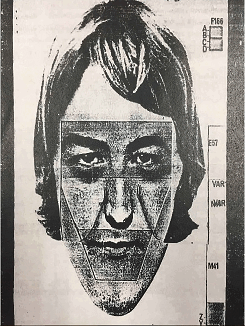 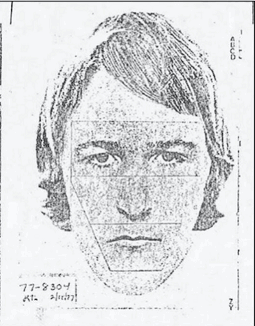 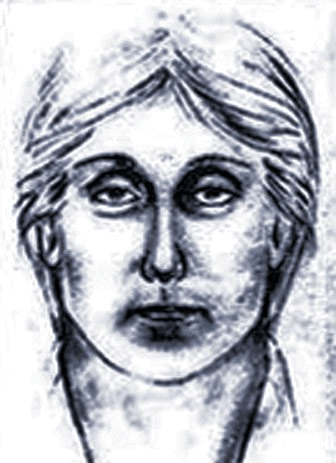
Strange ’70s days and nights— these sketches represent the perps on Sarda Way, September 14, 1973, Ripon Court, February 16, 1977, and a suspicious man thought to be EAR in the East Area, 1977. The last has a different part to his hair, but otherwise the fatigued look of the Sarda Way perp.
The presentation of the Sarda Way Incident by the Sac Sheriff’s cold case unit was just two months before DeAngelo was arrested. It caused a rush of emotion because it was viewed as potentially giving us the face of evil which so many had sought for so long. Even if the incident did not lead to EAR, at least we finally had a handle on what he looked like. The Sarda Way Incident is largely overlooked now, but it presents a genuine problem. Some of the EAR attacks are made by a villain who is described similarly and behaves in the same manner.
For instance, a man behaving in a similar manner to the Sarda Way perp would be identified prowling houses nearby to where the EAR would strike. A notable example was the week prior to the January 28, 1978, attack on the sisters on College View Way (No. 29/30). The prowler also wore a corduroy jacket, rang the bell, and then went in the backyard when the door was not answered.
It may seem as though I am creating confusion. You are correct. I am proving that confusion can be created, and that a reasonable doubt can be introduced that DeAngelo was the original and/or sole EAR unless the prosecution can neatly answer all the questions. To uncover there are more 1974 robbery cases in Rancho and the East Area bearing the mark of the Cordova Cat is to seriously undermine DeAngelo as the Cat and, with Sarda Way introduced, it gives us a link between a perpetrator in late 1973 to a prowler in January 1978 before an EAR attack and his resemblance to the Ripon Court Shooter of February 1977. This introduces the problem of another perp matching the description of the East Area Rapist who was consistently afoot in the East Area even at times when DeAngelo was far away in Exeter.
In between these benchmark cases, there is the October 21, 1975, rape on Dawes Street (Rancho C) and the first attacks of the EAR (summer 1976) ), two of which heavily suggest the unstoppable Sarda Way perp (Victim 3, Victim 7).
In and of itself the case of the Cat will not come directly into play because there were no murders involved in it. But the case of the East Area Rapist tardily involves a double murder— the Maggiores. They were murdered only a few days after the College View Way attack on the sisters. They were murdered in Rancho Cordova on February 2, 1978, by a prowler. A couple of decades after their murder, their case was attributed to the EAR. Unless there is something very specific traceable to DeAngelo, introducing evidence there was more than one such unrelated perpetrator afoot casts doubt on who murdered the Maggiores. Please see Moments in Crime and the Predator Walks Amongst Us to get a handle on how much prowling preceded the tragic night. Was a full time cop capable of this?
There is a bit of a “Catch 22” here. If wisely divorcing DeAngelo from the image of the blonde, weird Visalia Ransacker, yet still insisting he killed Snelling, it is implicitly saying that he had already masked his own crimes in Visalia by copying the Ransacker. Add to this yet again the evidence that the murders to which DeAngelo is tied by DNA bear the mark of imitating the Bedroom Basher and a pattern of copycatting is evident. Why could he not have copycatted the original East Area Rapist?
EAR or EARs?
It is actually less complex with the East Area Rapist case than the VR case to establish more than one perp was afoot because there are concise descriptions from witnesses at different EAR attacks. These are descriptions in perpetration and they describe radically different perpetrators and yet the M.O. is largely the same.
The first 8 EAR attacks are significant. They were before any news reports and the potential for inspiring (though unlikely) a quick copycat. Of these reports, the most detailed in perpetration description comes from EAR’s strike at Victim 7 on Kipling Drive (October 18, 1976), in which the 10 year old boy distinctly described the perp. One of the lead detectives, Lt. Richard Shelby, writes: “Ted [10 year old boy] said that he had dark-blue eyes and heavy, thick black hair on arms and legs.” The mother (victim) did not see him clearly but did notice the hair on his arms was dark.
This description of dark hair is found at the very beginning with Victim 1– Lt. Larry Crompton (Sudden Terror) mentions the victim said the assailant had dark hair on his arms and legs, but Shelby writes: “He had a lot of dark hair on his arms and legs.”
However, in assessing all 8 cases there is a problem. For starters, Victim 3 (Malaga Way, Rancho) lived only two houses away from Victim 1. Yet here the perp is described quite differently. Both mother and daughter said he had light hair (and not much of it) on his legs. This goes with someone who has light brown (dark blonde) hair, as the Sarda Way perp was described. But, and it is a big but, this doesn’t match the perp at Victim 1 and 7. At Victim 3, the perp also acts like the Sarda Way perp. Nothing stops him from entering, even when he knew he had been seen. The mother also thought that he was a bit small and in a fair fight she thought she could have taken him. This too sounds like the thin Sarda Way perp.
Someone with lots of hair on arms and legs can shave it, but they can’t grow hair where they don’t have it. The perp at Victim 3 did not have shaved legs, but sparse and light hair. Victim 16 would indeed introduce the possibility of shaved legs, but we will wait to address that in its turn because it doesn’t help here.
While an early copycat seems unlikely, within a year there evolved some suspicion that more than one creep was responsible for the series of terrorizing home invasion rapes in Sacramento. Since no DNA was preserved here, we must assess the cases in the old style– based on witnesses descriptions, M.O., patterns, etc.
This evolution can be concisely developed, thanks to the reporting on the matter by Lt. Richard Shelby in his book Hunting a Psychopath, which was based on his contemporary notes and later personal follow-up with victims for his book.
The first public report of a description of the East Area Rapist came at the Del Dayo school community meeting on November 4, 1976, when the announcement was made for the communities to be on the alert. Richard Shelby was there and gave the description of the perp. As reported in the Sacramento Bee: “Shelby said the suspect is white, has a pale complexion, may be between 5-feet, 8 inches to 6-feet tall, of a medium build, 25 to 35 years old and has dark hair which hangs over his ears to his collar.”
Although there is no victim report of EAR having shoulder length hair (due to the concealing ski mask), there must be some neighborhood canvas reports detailing the presence of such a man whose reason to be in the neighborhood was not known by the locals. Thus he became a “suspicious” person to the sheriffs. EAR did lots of pre-attack prowling, so there was a reason for the cops to collate reports of “suspicious” persons in the neighborhood and pick out the ones who could possibly have the dark hair on arms and legs. It was perfectly justified induction.
But the description of the perp at Victim 3 proved an impasse to the detectives. Again, the description of the perp as given by Rose (Victim 3) August 29, 1976, was of little visible hair on the arms and legs. He stood like a cop. Shelby writes: “[victim] described the suspect as a white male, between 18 and 30, light-complected and slim. His legs were well tanned, without much hair on them. He was not very heavy or very strong. She felt that in a fair fight she could take him, a sentiment to be shared by others. His estimated weight and height was 165 lbs, 5 ft. 9 inches.”
This must indeed have nagged at Shelby and members of the EAR Task Force. There is a good reason. The descriptions from victims 3 and 7 are not just from individuals. They are from 2 witnesses at each crime. Yet they give us radically different descriptions when it comes to the color and amount of hair on the visible parts of EAR’s body. One perp is not accomplice to the other. They are, as it stands, merely two radically different descriptions of what we rationalize to be the same perp. This is not just a disagreement between 2 witnesses. The two witnesses at each strike have descriptions that are sharply in contrast to the other two witnesses at the other attack. At one location he was not hairy but still pale (except for the tan legs); at the other he was hairy and pale.
The BOLO Shelby issued after the attack on Victim 7 on Kipling Drive immediately led to a perp he called “Art Pinkton”– blue eyes, right height (5 foot 9 inches), and when searched he even had a half bent spoon in his things like the one the detectives had found at the residence (under a couch) of Victim 7. Because decades later DNA ruled him out as being the ONS (and thus the three rapes in CCC) he has been dismissed as having been EAR. At the time of the DNA testing, unfortunately, the possibility of there having been two EARs (at least early-on) had been forgotten and, lamentably, there is no DNA in the Sacramento cases by which to compare.
From the above cases, one can see how by November 4, 1976, the sheriffs had determined EAR was quite naturally pale except for tanned legs during August. Things had leaned toward him being hairy.
This description was reconfirmed very soon. A few days after the school meeting in November, Victim 9 was hit. She was unable to get a glimpse of the assailant except for his ankles while he stood by her face and pulled up his socks. Even though this was at night on a dark canal under a weeping willow, she noticed his ankles were pale and he had dark hair on his legs.
The next most interesting description comes from Victim 13 (February 7, 1977) in Carmichael’s Del Campo Park area (actually right next to the park). Here too the assailant is described with hairy and very white legs. Although he arrived fully clothed, he did wear white boxers underneath. Victim estimated his age as 19-23. Here he was, however, about 5 foot 11 inches and about 185 pounds. (EAR was estimated at 5.7-9 at the earlier attacks). It is from the struggle here where EAR was cut and blood was left. It was tested and the results proved him to be A +. Crompton (Sudden Terror) writes the perp had hazel eyes. This could be a mistake, as Shelby later writes in his book (Hunting a Psychopath) that as of April 1977 “we were still thinking that the suspect most likely had blue eyes.” Shelby remained in contact with Victim 13, and it seems that if she had been certain about hazel eyes, as Crompton dramatizes, Shelby would have mentioned it. The references to blue eyes as late as April 1977 reflects the impression of certainty little “Ted” made on the investigators after the Kipling Drive attack in October 1976.
The attack on Victim 13 was at a critical juncture for SSD detectives in trying to determine EAR’s features. Here the neighborhood canvas uncovered reports of “suspicious” men seen in the neighborhood before-the-fact. Amongst the descriptions there is the description of the blonde-brown shoulder length hair young man.
Soon thereafter there occurred the Ripon Court Shooting (February 16, 1977). Sketches of the evil suspect were done, and he clearly had shoulder-length hair.
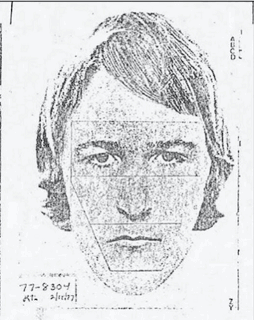 
These two sketches represent the perps on Ripon Court (1977), and a suspicious man in East Area, 1977.
These two sketches will prove significant then and, as we shall see, now.
More sketches would be made of “suspicious” young men seen in a neighborhood prior to additional EAR attacks, such as behind Victim 14’s house in March 1977. Put altogether, and EAR was slowly morphing into a much younger perp with brown-blonde shoulder length hair. Shelby would lower the suspected age to late teens to early 20s. Then a significant attack occurred.
On tax day (April 15, 1977) the East Area Rapist struck again in the Del Campo Park area. This was his third attack here. What is relevant here is that Kathy, the victim, got a glimpse of the perp (her blindfold came loose). As Shelby writes, she “. . .paid close attention to what she could see, and that was the hair on his legs and arms– of which there was not much. It was light brown, medium in texture, and definitely not coarse. . .She had gotten a brief glance at his eyes, which she was certain were brown. His head hair was cut to collar length and dark-blonde in color, straight, but also of a full bodied texture. As far as she could determine, he did not have any facial hair.” 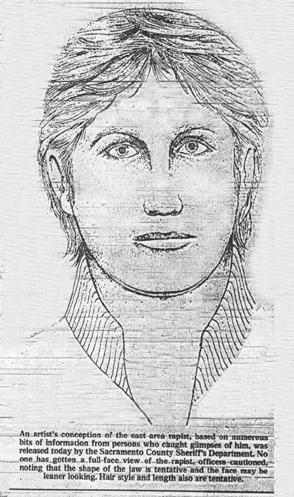
This must have clinched it for the investigators and allowed them to more critically collate the previous reports of “suspicious” young men seen in relation to previous attacks. Any collation, of course, highlighted that such a young man with dark-blonde collar length hair had been seen. Moreover, there was suspicion that the Ripon Court Shooter was EAR, and the sketch done of him in perpetration, as we have seen, showed he had collar length hair. Now they had this account from Victim 17– in perpetration. There was every reason for SSD to believe they were finally getting a handle on the East Area Rapist’s actual physical appearance (almost a year now after his first attack.)
On May 19, 1977, the first composite was released (left). It carried the hair style of the sketch above, right, but with a healthier, younger looking face.
There was a reason why Shelby wrote that Victim 17 had said the perp’s leg hair “was light brown, medium in texture, and definitely not coarse. . .” The reason for noting “not coarse” is because of the previous victim. Victim 16 in Orangevale described EAR’s thighs as wide and his hair felt like stubble, as if he shaved.
This hair difference is a hard point to get around. At some attacks EAR unquestionably had dark, hairy arms and legs, and lots of it. At others, like Victim 3 and 17, he had very little and it was light. I assume this is what nagged at Richard Shelby. He writes:
“This particular assault [Victim 17] occurred about the same time I told Lt. Root I could make a case for two suspects in the East Area Rapist series. In a heartbeat, he responded with, ‘I don’t want to hear about it.’ He went on to explain that to make that public would create more confusion and panic, in a public which already had a plentiful supply. ‘Go arrest them, then tell me about it,’ was his response.”
We are compelled now to face this deduction. Were there two perps categorized under the police moniker of the East Area Rapist?
For the sake of argument, how prolific was this “original” EAR?
This introduces the case of “Mr. Hairy Backside.” I insert this case here because it can have great bearing on the Maggiore case that forms the cornerstone of the upcoming trial (for Sacramento).
This case, the case of Victim No. 35, occurred in Davis, California, on June 24, 1978. Davis is a university town about 25 minutes west of Sacramento. There is found in this assault a description of the perp; and in the week before the attack there is a description of a “suspicious” man seen in the neighborhood peeping in windows.
First, the description of the perp. EAR was here described as having a noticeably hairy backside. The rules of circumstantial evidence, plus scientific method, and hence the criterion of logic, allow us one inference from a set of circumstances that can be established as fact. What can one infer from a hairy backside? Well, I would infer his legs were also hairy. The victims do not report hairy legs, however, at least from what Shelby presents. This is another observation. What can we infer from this? He shaved them.
These inferences do not stand alone on the merits of clues at No. 35. There are more observations and classifications that come into play in the greater EAR crime spree from the observations here. At Victim 16, once again, EAR was described as having wide thighs and it felt as if he shaved his legs– to the victim the hair felt “abrasive” like stubble. The EAR with the hairy backside at Victim 35 in Davis on Rivendell Street was also described as having “big thighs.” What do we infer here?
We infer the perp at No. 35 is the same creep at Victim 16. We therefore can infer that this perp was the same perp at Victim 1 and 7, where the perp was described as having thick, dark (and lots) of hair on his arms and legs. Did he shave those very hairy legs before the strike at Victim 16? The question is inductive, of course, but the facts do stand.
What did this alternate EAR look like? Presumably, he is the one who inspired the original estimation (November 4, 1976) of a perp with shoulder length dark hair. This introduces the “suspicious” man seen in the vicinity of Victim 35’s house peeping in windows before the attack. He had brown hair, now curly, but still shoulder length as was the fashion of the late 1970s.
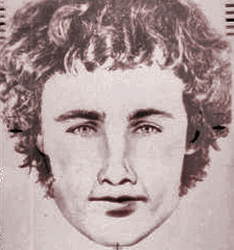
Davis sketch, June 1978.
To underscore the relevance: the above sketch is of a man seen peaking in neighborhood windows up to a week before the attack on Victim 35. One incident was on Shire Lane, a couple blocks over from the victim’s house on Rivendell.
In like manner a block over and a week before the attack on victims 29/30 a man rang the bell of a young woman alone. When she didn’t answer he went into the backyard. This is how the Sarda Way perp had behaved. In this case (on Locust Avenue), the girl fled the house out the front door. A week later and a block away a violent EAR kicks in the front door of the Victim 29/30’s house— just as the Sarda Way perp did with the September 1973 victim in Rancho.
So which perp is this shown above?
I have no description of the hair of this daytime prowler and yard invader on Locust Avenue, but a few days after the College View Way attack on the two sisters, there were the murders of the Maggiores. From the circumstances here I do have a description matching the above sketch. This man with curly brown hair was lurking in the shadows of the corner house on La Alegria and West La Loma Drive, Rancho Cordova. He was seen by a jogger. Time estimates place this man at this location minutes after a break-in of a duplex on Capitales (behind this corner house) and 10 minutes or so before Brian and Katie Maggiore were gunned down up La Alegria near where it meets with La Gloria.
This now introduces a very important case in the trial of J.J. DeAngelo.
The Maggiore Murders
The Maggiores’ murders were never linked to EAR back then. There wasn’t even immediate suspicion. Just remember Bill Miller’s heated response to Vaughn and McGowen when they implied (via the Union) that EAR was a killer in Visalia. Sacramento was scared enough of this unstoppable home terrorist, and now to say he was a killer sent thousands over the edge, at least according to Miller. And, of course, the circumstances of the Maggiore Double Murders are atypical of EAR’s actions.
The reasons why the murders later came to be associated with EAR is because a tied shoelace was found and, more interestingly, the area of Cordova Meadows had suffered a spate of prowlings and break-ins in similar fashion to EAR’s pre-attack stalking. This was unknown to the EAR Task Force at the time because homicide was investigating the murders, and apparently they knew nothing of EAR’s M.O.
Decades later the sequence of events was discovered and the cause and effect theoretically put back in place.
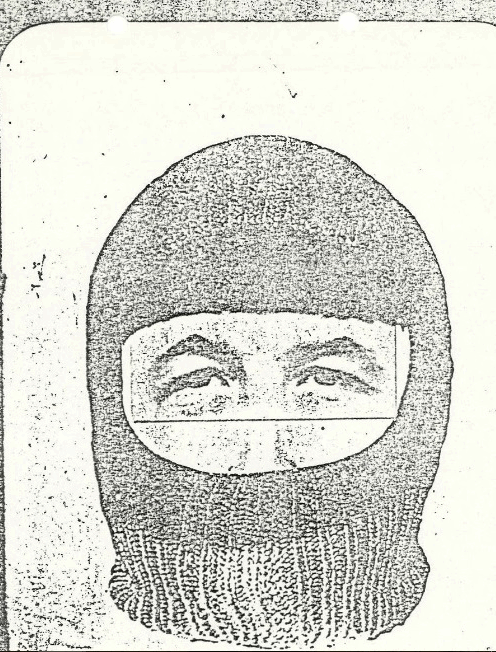 But it is a fact that the perp’s face was never seen in this motiveless murder. After shooting down the But it is a fact that the perp’s face was never seen in this motiveless murder. After shooting down the  Maggiores, he jumped the fence of a house, ran back in the direction to where the curly haired man had been standing 10 minutes before, but he then stopped. Young Karl Nollsch was standing in his driveway and was now an impasse. Nollsch reports he was wearing a ski mask. The perp turned around and ran the other way and jumped a fence back onto Capitales. Maggiores, he jumped the fence of a house, ran back in the direction to where the curly haired man had been standing 10 minutes before, but he then stopped. Young Karl Nollsch was standing in his driveway and was now an impasse. Nollsch reports he was wearing a ski mask. The perp turned around and ran the other way and jumped a fence back onto Capitales.
Therefore we only have the before-the-fact image of a man with curly brown hair standing in the shadows.
A month later a witness came forward and inspired a sketch that is not of a curly-haired man, however, but of a man with a short un-mussed haircut. This sketch has been used to connect DeAngelo to the crime. DeAngelo, of course, was a cop with a similar haircut, though he parted his on the right. This short-haired man was seen after-the-fact a couple of blocks away and apparently was the man seen earlier with a gun in his back pocket and holding a bundle in his hand which could have been the ski mask he had (by this time) removed.
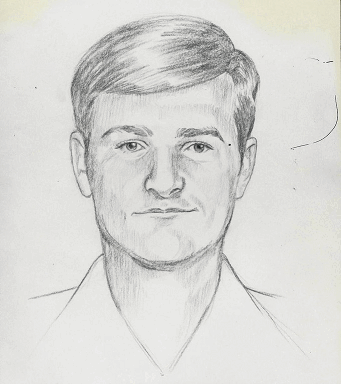
The sketch done a month after-the-fact based on the witness description.
So which witness is accurate? The one that night or the one a month after-the-fact? From a jury’s point of view, that is.
The young jogger was very keen, as you can see from his account– he even noted that although he did not see the dog the Maggiores were walking he did hear the chain. He places this curly-haired man in the shadows, and this was 10 minutes before the Maggiores were murdered. Who was he?
DeAngelo has been tagged as the guy with the short hair. The DA’s office has no DNA, but they are preparing a case to convict DeAngelo as the Maggiore double murderer. This page is neither yea nor nay regarding this. I am only acknowledging some hurdles to conviction.
The prowling, break-ins, and hang up phone calls are well-documented. They vexed Cordova Meadows since late Summer 1977 and came to a crescendo that very night. The man with curly hair was seen behind the area where the duplex had received the attempted break-in. He was in the bushes under the tree. Then 10 minutes later the murders occur. They did not occur in a random area of the neighborhood. The confrontation between Brian Maggiore and his killer took place in front of the house on La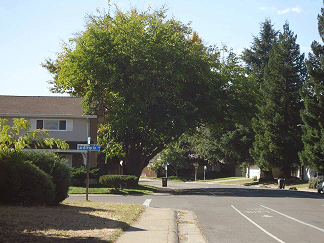 Gloria that had received the last hang up call that night. It would seem likely that after the failed break-in on Capitales the perp went to his next target. The curly-haired guy’s position on West La Loma fits with where the perp would need to be if moving from Capitales to La Gloria. He waits in the shadows until the people walking the dog pass. The hang up calls, the prowling, the break-ins, are obviously all connected to the events of that tragic night. Gloria that had received the last hang up call that night. It would seem likely that after the failed break-in on Capitales the perp went to his next target. The curly-haired guy’s position on West La Loma fits with where the perp would need to be if moving from Capitales to La Gloria. He waits in the shadows until the people walking the dog pass. The hang up calls, the prowling, the break-ins, are obviously all connected to the events of that tragic night.
So many EAR rape victims reported these hang up calls weeks prior to their attack. Many neighbors were also receiving them. It was as if the caller was trying to gauge the schedules of the block. Victim 17 reported she was receiving them 3 times a day— morning, noon, and night.
As with the case of Victim 17, the prosecution is going to have to show that DeAngelo was in a position to make all the hang-up phone calls that had been made to the neighborhood prior to the night of the murder . . . prior to and especially on the night of the murder. The calls came in at 8 PM each night. The last call the night of the murder was also at 8 PM. The break-in on Capitales must have been within 30 minutes of the last 8 PM call. DeAngelo could not have made it from Auburn in that amount of time. DeAngelo would need a local lair, not just for this night but for all the others. One can say DeAngelo called from a phone booth, but these calls had been happening over weeks if not months. Please see Moments in Crime
During this well-documented prowling glut in Cordova Meadows, “EAR” struck in Stockton (No. 23), No. 24 (La Riviera), No. 25 (Foothill Farms), No. 26 (Carmichael), No. 27 (La Riviera), No. 28 (Foothill Farms), Nos. 29/30 (Carmichael), most of these cases noteworthy for being hell and gone from previous comfort zones. Nos. 29/30 (January 28, 1978) were only a few days before February 2, 1978, the night the Maggiores died.
When did a married, full time cop living in Auburn have the time to do all of this? Not just availability on the nights of the rapes, but on all the days and nights of prowling and reconnoitering beforehand?
The prosecution must especially account for this curly hair man in the bushes and why the night of the crime he was described quite differently than the sketch of the supposed perp made a month later.
Without anything that specifically ties DeAngelo to the Maggiore crime scene, there could be real trouble hanging this tragic double murder on him. If the evidence which has made the prosecution confident that DeAngelo did this is evidence or clues that suggest EAR is responsible, then there truly is no specific evidence linking DeAngelo.
As we have seen, from the beginning the evidence has always been there to suggest more than one perpetrator was classified under the moniker East Area Rapist. DeAngelo has been thought guilty of being the Maggiore killer because he is believed to be the sole East Area Rapist, and the EAR has been believed to be the killer. But this belief was not contemporary.
Yet again, pattern is powerful. It is curious that if he committed all the murders, the murder of Claude Snelling and then the Maggiores did not inspire him to take up a murder spree. Yet the evidence shows that the impromptu murder of Offerman and Manning, also by gunshot, starts the Original Night Stalker onto a path of carefully planned murder that now mimics the Bedroom Basher (death by bludgeoning). DeAngelo can be tied to these via DNA, but not to Snelling or the Maggiores.
The theory that DeAngelo was to some extent copycatting other perpetrators is not unfounded from one piece of evidence gleaned in the crime sprees of the Cordova Cat, EAR, VR. From all the sketches of persons of interest, that is, “suspicious” persons seen in the neighborhood before-the-fact, none of them suggest DeAngelo. Or? Or perhaps he is responsible for only a fraction of the Ransacker and EAR crimes.
As a cop, the accused knew the details of the Ransacker and EAR crimes and was therefore in a position to tailor some of his alleged thrill crime spree to conform to that of the original perp. This would disguise his own crimes.
One powerful point for the prosecution is that DeAngelo can be tied to 3 Contra Costa County rapes. A copycat, as the word implies, has no original or inner inspiration, and a copycat crime spree is really quite unknown in criminology, especially in terms of thrill crime sprees. Copycats tend to commit individual acts and use the M.O. of a publicized criminal currently afoot in order to mask their own motive. Three rapes committed in CCC far from DeAngelo’s home of Auburn suggests far more than any copycat’s motive.
Still, this does not negate the evidence that indicates more than one perp was using a similar M.O. A couple of points should be touched on in conclusion.
It is to be noted that on a couple of occasions it was described as quite normal rather than the usual under endowment. Such a description, of course, is by feel, and therefore it is highly subjective. But it is curious to note that the first description of a normal sized organ is at Victim 17, where the victim described it as long as a dollar bill. (Victim 11 had said “better than her husband” but no one wants to go there.) Previously, EAR was described as having such an under-endowment that on occasion when he raped a virgin she was still a virgin afterward. Normal size organ would be repeated again at Victim 26. Yet the under-endowed EAR would strike again too, such as at Victim 32 in Little Pocket.
From the eyewitness evidence, we don’t have an early perp who did a few rapes and inspired a prolonged copycat. We seem to have an original EAR who continued on while there was another rapist afoot.
The concept of two EARs was fostered by certain changes in EAR’s M.O. For example, by Victim 12 (Primrose Drive) EAR seems to have lost his aggressive thrill for rape, and thereafter in his attacks he is usually more lackluster. The use of “mother—-r” arrives a bit late in his repertoire and is often overused. There are moments of stuttering and then there are not. The overuse of the sobbing routine came a bit late and can be interpreted as a response to the psychological theories reported in the newspapers. Much of EAR’s repertoire, in fact, is subject to interpretation. The dominant interpretation was that he was laying red herrings. He was trying to sound like a cheap punk, a psychotic, and someone far less educated than he was. But what if there were actually two different perps?
In terms of how this relates to the upcoming trial of J.J. DeAngelo, we must ask ourselves: which of these two descriptions fit him best? Actually, neither. One sounds like an unknown, hairy perp, and the other sounds like the Sarda Way perp. But since DeAngelo doesn’t have profuse hair on arms and legs, we should opt for the perp who had little hair on arms and legs. We must explain the shoulder length hair seen by Victim 17 as representing a wig, despite the fact he also had on a ski mask over the wig. Those young men seen in the neighborhood who had brown-blonde hair we must write off as innocent bystanders and coincidences.
A trial cannot determine who these perpetrators were. But as it relates to DeAngelo, the crux of the matter is the question of whereabouts. If during the trial, DeAngelo can be confirmed to have been elsewhere during one of the attacks, we not only have another East Area Rapist, we have the original East Area Rapist.
For the defense to prove DeAngelo could not have been the Cordova Cat, Sarda Way perp, in addition to proving he could not have done some of the Sacramento rapes, would be incredibly powerful. This brings the Ripon Court shooting into play, and many other incidents, indicating another violent perp was afoot.
Perhaps it is beneficial that DeAngelo has been charged with so much. The prosecution must be ready to counter all arguments. As much as it convicts, the trial of J.J. DeAngelo must explain. A lot of reasonable doubt exists whether there were 2 EARs. And this doubt was increased with the arrest of DeAngelo. The surprise was first voiced by one of the detectives in Orange County, Larry Poole, when he said that he couldn’t imagine when DeAngelo slept. The EAR was so prolific over a wide range of territory that on the face of it a full time police officer could not have been able to pull off all of the crimes, especially when adding all the dates of the prowling reports.
|